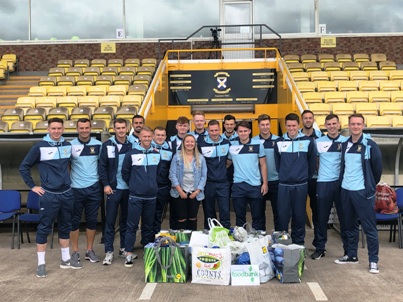Home
East Fife helps out Levenmouth Foodbank
On Saturday, 4th August, the East Fife Supporters, Players and Club responded magnificently to an appeal to replenish the local foodbank. Isla English was overwhelmed and was extremely grateful for the amount of donations. When our players' Captain, Kevin Smith, heard about the appeal, he immediately went to his players and raised a significant amount of cash to buy goods. The Club matched this amount and , of course, both sets of supporters really outshone themselves with their donations. The photos show the amount collected by the Players before the match and a car being fully loaded (this was the first load and another full car took up the remainder).
WELL DONE THE FIFE


EFTV 2018/2019 Season Preview
With only 2 days to go until the start of our 2018/2019 League 1 campaign, we asked some of our season ticket holders for their thoughts ahead of the new season
Admission Prices For Falkirk Cup Tie
We welcome Falkirk to The Locality Hub Bayview Stadium on Saturday for our final Group B match in the Betfred Cup. Admission prices for this match are as follows
Adults £10
Under 16s £5
The Jeek Flaming Suite and Jimmy’s Bar will be open to both sets of supporters from 12.30 pm.
Links Park Challenge Up Next for Darren’s Fifers
East Fife are on their travels again this evening as they head to Angus to take on a Montrose side who have been rejuvenated in the last 12 months, winning the SPFL division two championship last season. Stewart Petrie’s team are also off to a flying start in the Betfred Cup, recording an impressive 1-0 victory in Falkirk on Saturday, thanks to an early goal from Martin Rennie.
Bayview boss Darren Young was also a happy man following his side’s goalless draw with St Johnstone at McDiarmid Park at the weekend. Despite missing out on a bonus point following the penalty shoot-out, there were many positives to take from a very encouraging performance, as the Fifers restricted their Premiership opponents to only a few goalscoring opportunities with a well-organised display and some resolute defending, particularly at set-piece situations.
In terms of personnel, East Fife should be along the same lines, with goalkeeper Craig McDowall, Scott Linton and Mark Docherty still sidelined through injury. Midfielder Scott Agnew is expected to be available for selection for Sunday’s game against Forfar Athletic at Locality Hub Bayview Stadium.
There are several familiar faces in the Montrose squad, including ex-Fifers Allan Fleming, Ross Campbell and Jordan Millar. The Gable Endies have also recruited Josh Skelly and Patrick Cregg from Arbroath and Forfar Athletic respectively during the summer.
East Fife’s record in recent years against Montrose has been decent, but they will be aware that the Angus side’s form has been excellent and can boast an unbeaten run at Links Park, stretching back to January. An interesting contest awaits.
